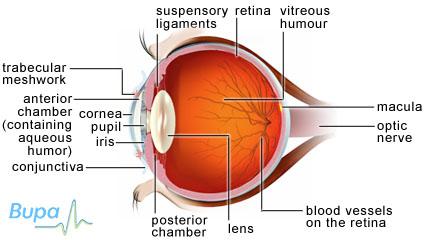Cataracts

This factsheet is for people who have cataracts or who would like information about them.
A cataract is a painless clouding of the lens of the eye. Cataracts generally develop over a long period of time, causing eyesight to gradually get worse. They can, if severe, lead to blindness if left untreated.
About cataracts
Symptoms of cataracts
Complications of cataracts
Causes of cataracts
Diagnosis of cataracts
Treatment of cataracts
About cataracts
In the UK, you’re more likely to get cataracts as you get older. About a third of people aged over 65 have cataracts in one or both eyes.
Cataracts can usually be treated with surgery, but you only need to have surgery if the cataracts are affecting your vision in such a way that you’re unable to pursue or enjoy day-to-day activities such as reading, driving or leisure activities.
The eye
Your eye is ball-shaped and contains fluid.
Near the front of your eye is the lens, which sits behind the iris – the coloured part of your eye. The lens helps you to see things in focus. It directs light rays on to the back of your eyeball (retina), to form an image, which is then sent to your brain.
The lens is normally clear, and it can change its shape to allow you to see things near and far away. When the lens becomes cloudy it's called a cataract.
Types of cataract
There are two main types of cataract.
- Age-related cataracts, which are the most common type.
- Cataracts present at birth (congenital cataracts). These affect between one and six in every 10,000 babies and are usually diagnosed at birth. It’s important to get treatment early as congenital cataracts can permanently affect a baby’s eyesight. Visual development occurs very early in infancy. If left untreated, cataracts can cause visual impairment even if they are removed later in life.
Cataracts can also be the result of rare diseases or local eye injuries and inflammation (for information, see Causes).
This factsheet is about adult cataracts.
Symptoms of cataracts
If you have a cataract, you may have no symptoms. Alternatively, you may have one or more of the symptoms listed below.
- Your vision may get worse, and seem cloudy, fuzzy or filmy – as though you’re looking through fog.
- You may have spots in your vision and might mistakenly think your glasses have spots of dirt or scratches on the lenses.
- You may get more glare (dazzling) or see halos from lights or the sun. This can be severe. It may make driving at night difficult because of the glare caused by oncoming vehicle headlights.
- Colours may seem washed out or faded.
Complications of cataracts
If left untreated, cataracts may eventually lead to blindness. In the UK, cataracts are normally diagnosed and treated well before they severely affect your vision.
Causes of cataracts
Cataracts are caused by changes in the structure of the lens of your eye.
As you get older, you’re more likely to develop cataracts. Women are more at risk than men. There are other factors that can increase your risk of getting cataracts. These include:
- diabetes
- an injury to the eye
- other eye problems
- exposure to ultraviolet (UV) light from sunlight
- long-term use of steroid medicines
- smoking
- drinking too much alcohol
- a family history of cataracts
- high blood pressure
Diagnosis of cataracts
A GP, an optometrist (a health professional who examines eyes, tests sight and dispenses glasses and contact lenses) or an ophthalmologist (a doctor specialising in eye health) will look into your eyes using a special instrument called an ophthalmoscope.
Eye tests using standard charts will help identify worsening eyesight. It's quite common to be diagnosed with a cataract during a routine eye test without having any symptoms as changes in the lens tend to occur gradually over many years.
Treatment of cataracts
If you have cataracts, you may find that your vision is still good enough when wearing your glasses or contact lenses. But you might consider treatment if your vision has become noticeably worse or can't be corrected with a change in your prescription lenses, and it‘s interfering with your everyday activities such as work or hobbies.
Left untreated, your lens may become so cloudy that it's impossible to see any detail, although you will always be able to see some light.
Self-help
Wearing glasses may improve your vision to begin with, but your cataracts will probably get worse over time, so this will only be a temporary solution.
There is no known way to prevent cataracts that develop as a result of getting older.
Medicines
So far, no medicine or diet has been found to slow down the growth of cataracts, and there isn’t a medicine that can clear a clouded lens.
Surgery
Removing the cloudy lens and putting a new lens in is the only way to improve your vision. The most common operation for this is called phacoemulsification. The cloudy lens is destroyed with sound waves and taken out, and a lens made of a clear artificial material, such as plastic or silicone, is put in. This is usually done under local anaesthesia or with anaesthetic drops. The anaesthetic completely blocks the feeling from the eye area and you will stay awake during the operation.
This section contains answers to common questions about this topic. Questions have been suggested by health professionals, website feedback and requests via email.
Can I drive if I have cataracts?
How quickly will I lose my sight?
Can my cataract come back if I have it removed?
Can I drive if I have cataracts?
This depends on how advanced your cataract is, and whether just wearing glasses is enough to help with your vision.
Explanation
By law, your vision must meet set standards in order to hold a driving licence. These criteria are set by the Driving and Vehicle Licensing Agency (DVLA).
The DVLA requires you to be able to read a vehicle's registration plate in good light, while wearing glasses or contact lenses if you use them, from 20 metres away (20.5 metres for vehicles older than September 2001). You shouldn’t drive if you can’t read from this distance. You may find that glare is a problem (for example, from oncoming vehicle headlights when driving at night), even if your vision is otherwise fine.
If you’re concerned whether your vision meets the DVLA standards, book an eyesight test with your optometrist. If your eyesight isn’t good enough to drive but you wish to keep driving, you will need cataract surgery. If the vision in your other eye is good, you can still meet the driving standards (although it can take time to adapt to driving with good vision in only one eye).
Sources
- A guide to visual standards for drivers. Directgov – motoring. www.direct.gov.uk, accessed 28 March 2010
- Cataract, senile. eMedicine. www.emedicine.medscape.com, accessed 28 March 2010
How quickly will I lose my sight?
This varies considerably from person to person.
Explanation
Your vision will probably keep getting worse if you don't have your cataract removed. In most people, this happens slowly, over a matter of years. People often don’t know they have cataracts because the changes are gradual. Occasionally, cataracts develop quickly. The speed at which your sight gets worse varies from person to person, and may be faster in one eye than the other.
The good news is that as long as your visual loss is only caused by the cataract, then even if you do reach a level where you have almost completely lost your sight, your vision can usually be restored with surgery.
Sources
- Cataract. BMJ Clinical Evidence. www.clinicalevidence.bmj.com, accessed 28 March 2010
- Cataracts. eMedicine. www.emedicinehealth.com , accessed 28 March 2010
- Cataract – specialist management. Map of Medicine. www.healthguides.mapofmedicine.com, accessed 28 March 2010
Can my cataract come back if I have it removed?
No, a cataract can't come back once it has been removed.
Explanation
Once you have had your cataract surgically removed, it won't come back again, although it’s possible to get a cataract in your other eye.
However, it’s not uncommon to develop a condition after surgery called posterior capsule opacification (PCO). This makes your vision cloudy, but it isn't the same as having a cataract. It’s caused by a thickening of the natural lens casing – the part of your eye that holds your lens in place. This lens casing isn't usually removed during surgery but holds the new lens which replaces the cataract.
PCO generally develops within two years of having surgery, but can sometimes come on many years later. You will need a relatively minor procedure using a laser to correct your vision. The procedure (known as a capsulotomy) is quick and painless. Your pupil will be dilated with eye drops and anaesthetic drops will be given. You will be asked to sit with your chin rested on a machine and a special contact lens will be applied to the surface of the eye. The surgeon directs the laser with the aid of the contact lens to break the cloudy centre of the lens casing. Your vision will usually be restored straight away, although very occasionally you may get inflammation, which will require further treatment.
Sources
- Cataract – specialist management. Map of Medicine. www.healthguides.mapofmedicine.com, accessed 28 March 2010
- Understanding cataracts. Royal College of Ophthalmology. www.rcophth.ac.uk, accessed 28 March 2010
Related topics
Cataract surgery
Related topics
Cataract surgery
Further information
-
Royal College of Ophthalmologists
www.rcophth.ac.uk -
Royal National Institute of the Blind (RNIB)
0303 123 9999
www.rnib.org.uk -
Fight for Sight
020 7929 7755
www.fightforsight.org.uk
Sources
- Cataract – suspected. Map of Medicine. www.healthguides.mapofmedicine.com, accessed 28 March 2010
- Cataract. BMJ Clinical Evidence. www.clinicalevidence.bmj.com, accessed 28 March 2010
- Cataract – specialist management. Map of Medicine. www.healthguides.mapofmedicine.com, accessed 28 March 2010
- Cataract, congenital. eMedicine. www.emedicine.medscape.com, accessed 28 March 2010
- Long V, Chen S, Hatt SR. Surgical interventions for bilateral congenital cataract. Cochrane Database of Systematic Reviews 2006, Issue 3. Art. No.: CD003171. DOI: 10.1002/14651858.CD003171.pub2,
- Understanding cataracts. Royal College of Ophthalmology. www.rcophth.ac.uk, accessed 28 March 2010
- Cataract, senile. eMedicine. www.emedicine.medscape.com, accessed 28 March 2010
- Cataract – suspected. Map of Medicine. www.mapofmedicine.com, accessed 28 March 2010 (ie uveitis)
- Understanding cataracts. Royal College of Ophthalmology. www.rcophth.ac.uk, accessed 28 March 2010
- Cataract – specialist management. Map of Medicine. www.mapofmedicine.com, accessed 28 March 2010
















